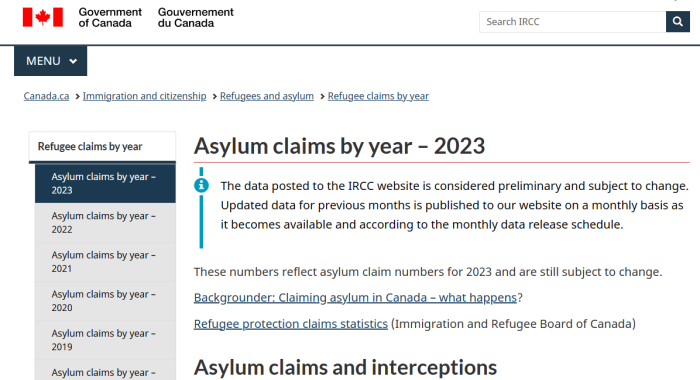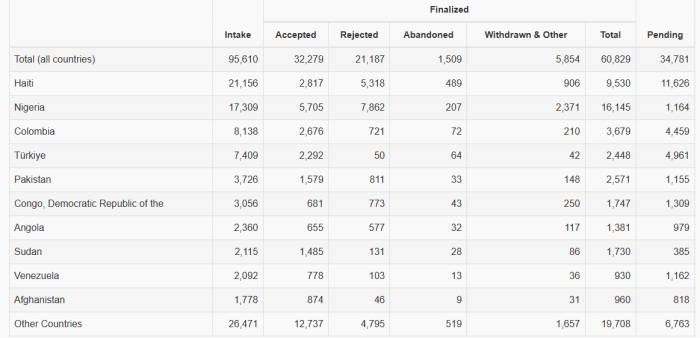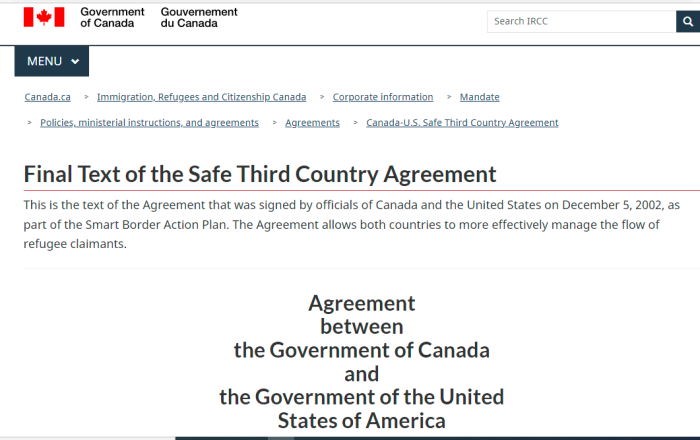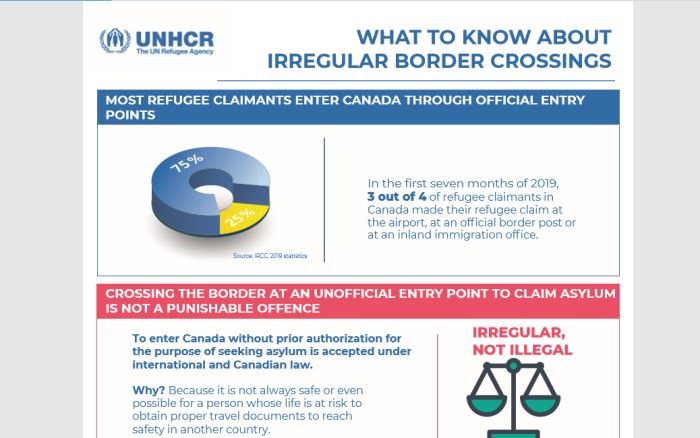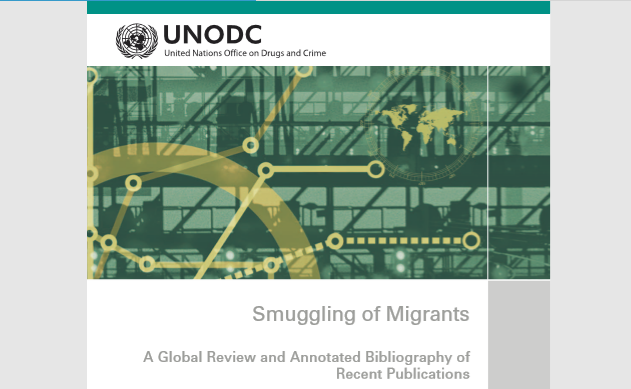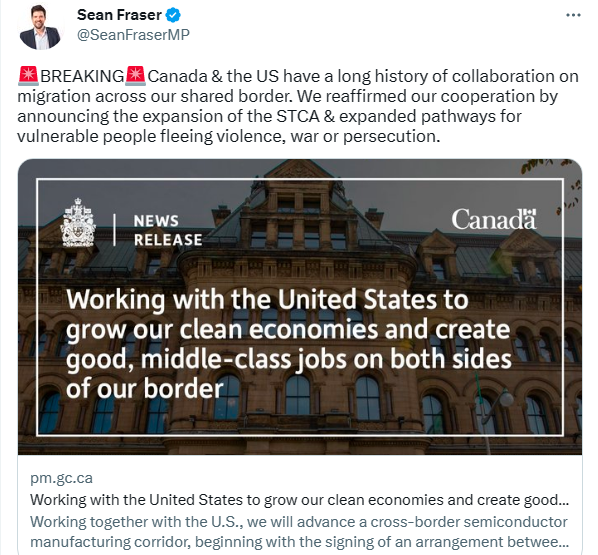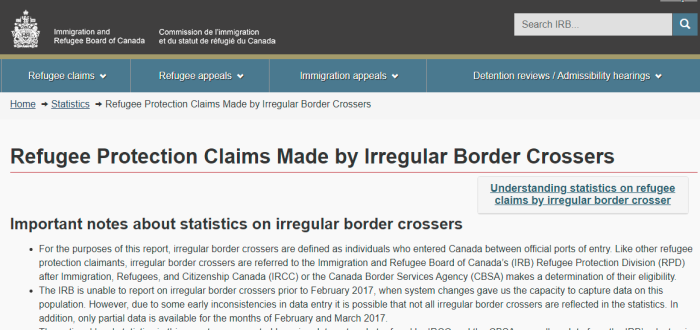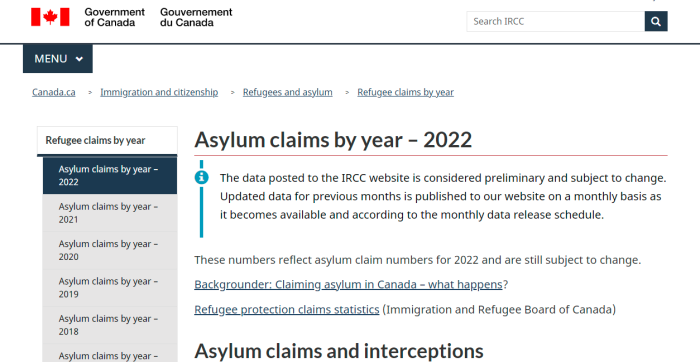
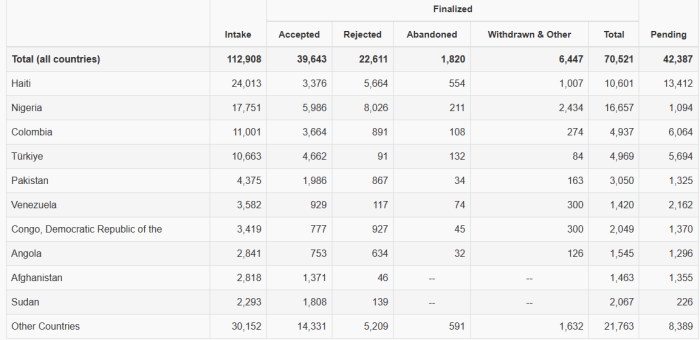
In the first few months of 2023, there were over 4,000 people crossing into Canada illegally. But after changes were announced to apply the Safe Third Country Agreement to the entire Canada/U.S. border, it dropped to an average of about 100.
This of course confirms what many had said all along: the Government could have stopped people from entering illegally at any time if it wanted to. However, politicians simply pretended to be helpless to stop this from happening.
Since January 2017, there have been almost 113,000 illegal crossings into Canada from the U.S. The top 5 source countries have been:
(a) Haiti
(b) Nigeria
(c) Columbia
(d) Turkey
(e) Pakistan
Of course, there is a major disclaimer. This data only are what’s being reported, and doesn’t include anyone who’s slipped across the border unnoticed. The numbers could always be — and likely is — much higher than this.
| PROVINCE/TERRITORY | 2011 | 2012 | 2013 | 2014 | 2015 | 2016 |
|---|---|---|---|---|---|---|
| Newfoundland | 0 | 0 | 0 | 0 | 0 | 0 |
| Prince Edward Island | 0 | 0 | 0 | 0 | 0 | 0 |
| Nova Scotia | 0 | 0 | 0 | 0 | 0 | 0 |
| New Brunswick | 10 | 5 | 5 | ? | ? | 25 |
| Quebec | 1,335 | 1,295 | 785 | 875 | 1,035 | 2,595 |
| Ontario | 2,660 | 2,340 | 1,995 | 2,630 | 2,790 | 3,7935 |
| Manitoba | 20 | 15 | 25 | 10 | 225 | 505 |
| Saskatchewan | ? | ? | ? | ? | ? | 30 |
| Alberta | 35 | 40 | 35 | 65 | 70 | 120 |
| British Columbia | 125 | 85 | 110 | 130 | 170 | 220 |
| Yukon | 0 | 0 | 0 | 0 | 0 | 5 |
| Northwest Territories | 0 | 0 | 0 | 0 | 0 | 0 |
| Nunavut | 0 | 0 | 0 | 0 | 0 | 0 |
| TOTALS | 4,185 | 3,770 | 2,955 | 3,715 | 4,290 | 7,365 |
Illegals were still coming into Canada via land border crossings during the Harper years. Interestingly though, it only receives major attention when Liberals are in power. A cynic may wonder why.
| YEAR: 2017 | |||||
|---|---|---|---|---|---|
| MONTH | QUEBEC | MANITOBA | B.C. | OTHERS | TOTAL |
| January | 245 | 19 | 46 | 5 | 315 |
| February | 452 | 142 | 84 | 0 | 678 |
| March | 654 | 170 | 71 | 2 | 897 |
| April | 672 | 146 | 32 | 9 | 859 |
| May | 576 | 106 | 60 | 0 | 742 |
| June | 781 | 63 | 39 | 1 | 884 |
| July | 2,996 | 87 | 51 | 0 | 3,314 |
| August | 5,530 | 80 | 102 | 0 | 5,712 |
| September | 1,720 | 78 | 79 | 4 | 1,881 |
| October | 1,755 | 67 | 68 | 8 | 1,890 |
| November | 1,539 | 38 | 46 | 0 | 1,623 |
| December | 1,916 | 22 | 40 | 0 | 1,978 |
| TOTAL | 18,836 | 1,018 | 718 | 22 | 20,593 |
| YEAR: 2018 | |||||
|---|---|---|---|---|---|
| MONTH | QUEBEC | MANITOBA | B.C. | OTHERS | TOTAL |
| January | 1,458 | 18 | 41 | 0 | 1,517 |
| February | 1,486 | 31 | 48 | 0 | 1,565 |
| March | 1,884 | 53 | 33 | 0 | 1,970 |
| April | 2,479 | 50 | 31 | 0 | 2,560 |
| May | 1,775 | 36 | 53 | 0 | 1,869 |
| June | 1,179 | 31 | 53 | 0 | 1,263 |
| July | 1,552 | 51 | 31 | 0 | 1,634 |
| August | 1,666 | 39 | 39 | 3 | 1,747 |
| September | 1,485 | 44 | 68 | 4 | 1,601 |
| October | 1,334 | 23 | 37 | 0 | 1,394 |
| November | 978 | 23 | 18 | 0 | 1,019 |
| December | 1,242 | 11 | 27 | 0 | 1,280 |
| TOTAL | 18,518 | 410 | 479 | 7 | 19,419 |
| YEAR: 2019 | |||||
|---|---|---|---|---|---|
| MONTH | QUEBEC | MANITOBA | B.C. | OTHERS | TOTAL |
| January | 871 | 1 | 16 | 1 | 888 |
| February | 800 | 1 | 6 | 2 | 808 |
| March | 967 | 13 | 22 | 0 | 1,002 |
| April | 1,206 | 15 | 25 | 0 | 1,246 |
| May | 1,149 | 27 | 20 | 0 | 1,196 |
| June | 1,536 | 26 | 5 | 0 | 1,567 |
| July | 1,835 | 23 | 15 | 1 | 1,874 |
| August | 1,712 | 26 | 22 | 2 | 1,762 |
| September | 1,706 | 19 | 17 | 0 | 1,737 |
| October | 1,595 | 18 | 8 | 1 | 1,622 |
| November | 1,118 | 9 | 21 | 0 | 1,148 |
| December | 1,646 | 2 | 5 | 2 | 1,653 |
| TOTAL | 16,136 | 180 | 182 | 9 | 16,503 |
| YEAR: 2020 | |||||
|---|---|---|---|---|---|
| MONTH | QUEBEC | MANITOBA | B.C. | OTHERS | TOTAL |
| January | 1,086 | 7 | 7 | 0 | 1,100 |
| February | 976 | 2 | 2 | 0 | 980 |
| March | 930 | 7 | 18 | 0 | 955 |
| April | 1 | 0 | 5 | 0 | 6 |
| May | 17 | 0 | 4 | 0 | 21 |
| June | 28 | 1 | 3 | 1 | 33 |
| July | 29 | 2 | 17 | 0 | 48 |
| August | 15 | 3 | 0 | 0 | 18 |
| September | 30 | 4 | 7 | 0 | 41 |
| October | 27 | 0 | 4 | 0 | 31 |
| November | 24 | 0 | 8 | 0 | 32 |
| December | 26 | 2 | 8 | 0 | 36 |
| TOTAL | 3,189 | 28 | 84 | 1 | 3,302 |
| YEAR: 2021 | |||||
|---|---|---|---|---|---|
| MONTH | QUEBEC | MANITOBA | B.C. | OTHERS | TOTAL |
| January | 28 | 1 | 10 | 0 | 39 |
| February | 39 | 0 | 1 | 0 | 40 |
| March | 29 | 5 | 2 | 0 | 36 |
| April | 29 | 2 | 2 | 0 | 33 |
| May | 12 | 3 | 13 | 0 | 28 |
| June | 11 | 0 | 6 | 0 | 17 |
| July | 28 | 5 | 6 | 0 | 39 |
| August | 63 | 2 | 11 | 0 | 76 |
| September | 150 | 0 | 19 | 0 | 169 |
| October | 96 | 0 | 17 | 0 | 113 |
| November | 832 | 1 | 12 | 0 | 845 |
| December | 2,778 | 0 | 33 | 0 | 2,811 |
| TOTAL | 4,095 | 19 | 132 | 0 | 4,246 |
| YEAR: 2022 | |||||
|---|---|---|---|---|---|
| MONTH | QUEBEC | MANITOBA | B.C. | OTHERS | TOTAL |
| January | 2,367 | 0 | 16 | 0 | 2,383 |
| February | 2,154 | 1 | 9 | 0 | 2,164 |
| March | 2,492 | 2 | 8 | 0 | 2,502 |
| April | 2,791 | 3 | 8 | 3 | 2,805 |
| May | 3,449 | 3 | 40 | 1 | 3,493 |
| June | 3,066 | 3 | 14 | 3 | 3,086 |
| July | 3,645 | 3 | 29 | 0 | 3,677 |
| August | 3,234 | 5 | 10 | 0 | 3,249 |
| September | 3,650 | 10 | 0 | 0 | 3,660 |
| October | 3,901 | 16 | 34 | 0 | 3,951 |
| November | 3,731 | 23 | 34 | 0 | 3,788 |
| December | 4,689 | 3 | 52 | 1 | 4,745 |
| TOTALS | 39,171 | 72 | 289 | 7 | 39,540 |
| YEAR: 2023 | |||||
|---|---|---|---|---|---|
| MONTH | QUEBEC | MANITOBA | B.C. | OTHERS | TOTAL |
| January | 4,875 | 19 | 100 | 0 | 4,994 |
| February | 4,517 | 5 | 59 | 0 | 4,581 |
| March | 4,087 | 15 | 71 | 0 | 4,173 |
| April | 69 | 9 | 26 | 0 | 104 |
| May | 46 | 3 | 30 | 0 | 79 |
| June | 30 | 1 | 27 | 2 | 60 |
| July | 42 | 8 | 33 | 0 | 83 |
| August | 53 | 3 | 40 | 1 | 97 |
| September | 59 | 2 | 25 | 2 | 88 |
| October | 36 | 7 | 29 | 3 | 75 |
| November | 58 | 0 | 37 | 0 | 95 |
| December | 90 | 5 | 131 | 0 | 226 |
| TOTAL | 13,962 | 77 | 616 | 8 | 14,663 |
| YEAR: 2024 | |||||
|---|---|---|---|---|---|
| MONTH | QUEBEC | MANITOBA | B.C. | OTHERS | TOTAL |
| January | 79 | 16 | 91 | 5 | 191 |
| February | 75 | 8 | 94 | 1 | 178 |
Interestingly, the numbers in British Columbia are actually rising lately. While it’s nowhere near the levels of Roxham Road, it could indicate that people are looking at other alternatives.
Some other useful information:
First, in 2019, something happened that wasn’t really reported on. It was that the Canadian Government scrapped the DCO, or Designated Country of Origin policy. This stopped people from 42 countries (mainly in Europe) from being able to abuse the refugee system with bogus claims.
Second, as for the Safe Third Country Agreement, people are still allowed to enter, and it’s still being gamed by human smugglers and traffickers. Few people know this, but the Treaty is actually a 3-way arrangement with the UNHCR acting as a sort of facilitator. True, the amended agreement has cut the number of interceptions, but is that really the whole story?
Third, the United Nations — a party to U.S/Canada border security — distributes information packages on how to circumvent the Safe Third Country Agreement. While claiming to care about the integrity of countries, they publish materials to do exactly the opposite.
Fourth, the U.N. has extensively studied the connection between lack of border enforcement, and the facilitation of human smuggling and trafficking. It isn’t a surprise that open borders lead to increases in illegal crossings. They know exactly what’s going on.
True, changes to the Safe Third Country Agreement seem to have resulted in fewer people entering illegally. That’s certainly positive. However, this pales in comparison to the vast numbers that are entering legally through various channels. But that’s a story for another time.
And while these are the official numbers that get reported, it would be helpful to know how many people come in that are either undetected, or simply aren’t documented.
(1) https://www.irb-cisr.gc.ca/en/statistics/Pages/irregular-border-crossers-countries.aspx
(2) https://www.canada.ca/en/immigration-refugees-citizenship/services/refugees/asylum-claims/processed-claims.html
(3) https://www.canada.ca/en/immigration-refugees-citizenship/services/refugees/asylum-claims/asylum-claims-2017.html
(4) https://www.canada.ca/en/immigration-refugees-citizenship/services/refugees/asylum-claims/asylum-claims-2018.html
(5) https://www.canada.ca/en/immigration-refugees-citizenship/services/refugees/asylum-claims/asylum-claims-2019.html
(6) https://www.canada.ca/en/immigration-refugees-citizenship/services/refugees/asylum-claims/asylum-claims-2020.html
(7) https://www.canada.ca/en/immigration-refugees-citizenship/services/refugees/asylum-claims/asylum-claims-2021.html
(8) https://www.canada.ca/en/immigration-refugees-citizenship/services/refugees/asylum-claims/asylum-claims-2022.html
(9) https://www.canada.ca/en/immigration-refugees-citizenship/services/refugees/asylum-claims/asylum-claims-2023.html
(10) https://www.canada.ca/en/immigration-refugees-citizenship/services/refugees/asylum-claims/asylum-claims-2024.html
(11) https://www.canada.ca/en/immigration-refugees-citizenship/news/2019/05/canada-ends-the-designated-country-of-origin-practice.html
(12) https://www.canada.ca/en/immigration-refugees-citizenship/corporate/mandate/policies-operational-instructions-agreements/agreements/safe-third-country-agreement/final-text.html
(13) https://canucklaw.ca/tsce-10c-bit-of-history-doug-rob-ford-voted-in-2013-for-sanctuary-toronto-amnesty-for-illegals/
(14) https://www.canada.ca/en/immigration-refugees-citizenship/news/2019/05/canada-ends-the-designated-country-of-origin-practice.html
(15) https://www.canada.ca/en/immigration-refugees-citizenship/corporate/mandate/policies-operational-instructions-agreements/agreements/safe-third-country-agreement/final-text.html
(16) https://www.canada.ca/en/immigration-refugees-citizenship/corporate/mandate/policies-operational-instructions-agreements/agreements/safe-third-country-agreement.html
(17) UNHCR Information On Circumventing Border Security
(18) https://www.unodc.org/documents/human-trafficking/Migrant-Smuggling/Smuggling_of_Migrants_A_Global_Review.pdf

